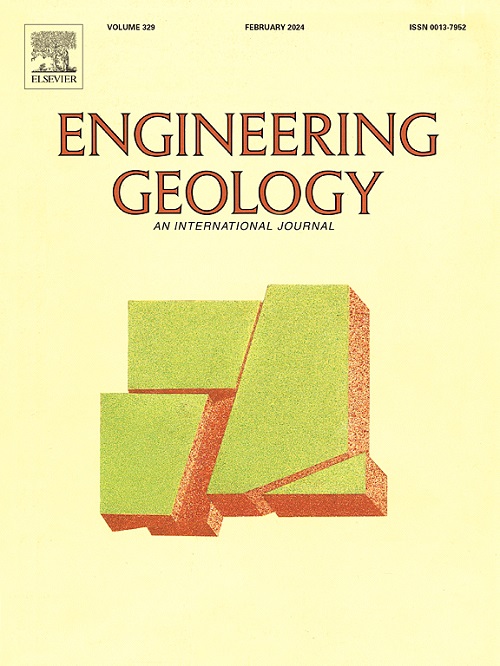利用隧道中动态裸露岩石图像的断裂分布时空预报方法:方法与应用
IF 6.9
1区 工程技术
Q1 ENGINEERING, GEOLOGICAL
引用次数: 0
摘要
预测未开挖隧道断面岩石裂缝的几何特征对于施工安排至关重要。本文提出了一种从时空角度预测隧道工作面附近断裂分布的方法。我们创新性地将隧道开挖里程类比为时间序列数据。利用分形几何学和地质统计学,我们提取了周边岩石断裂的几何特征,并建立了用于动态预测的时空数据集。SCINet 模型是一个空间感知递归神经网络,用于确定性-随机动态预测。通过数值模拟,验证了该模型对各种分布(包括轨迹长度、倾角和密度)的预测准确性。值得注意的是,轨迹长度预测的平均绝对百分比误差(MAPE)非常低,仅为 5.49%,Kullback-Leibler(KL)发散低至 4.81%。该方法还进一步应用于中国的一个地下储油洞,揭示了结构面信息。通过纳入连续暴露的断裂数据,预测精度逐步提高,证明了该方法作为一种预测工具在提高隧道施工安全和效率方面的潜力。本文章由计算机程序翻译,如有差异,请以英文原文为准。
A spatio-temporal forecasting method of fracture distribution using dynamically exposed rock images in tunnel: Methodology and application
Forecasting the geometric characteristics of rock fractures in unexcavated tunnel sections is crucial for construction arrangements. This paper presents a method for predicting fracture distribution near the tunnel face from a spatiotemporal perspective. We Innovatively analogize the tunnel excavation mileage as the time series data. Using fractal geometry and geostatistics, we extract geometric features of peripheral rock fractures and establish a spatiotemporal dataset for dynamic prediction. The SCINet model, a spatial-aware recursive neural network, is employed for deterministic-stochastic dynamic prediction. Numerical simulations are conducted to validate the predictive accuracy of the model for various distributions, including trace length, dip angle, and density. Notably, the Mean Absolute Percentage Error (MAPE) for trace length prediction is remarkably low at 5.49 %, and the Kullback-Leibler (KL) divergence is as low as 4.81 %. The method is further applied to an underground oil storage cavern, China, revealing structural surface information. By incorporating continuously exposed fracture data, prediction accuracy is progressively improved, demonstrating the method's potential as a predictive tool for enhancing tunnel construction safety and efficiency.
求助全文
通过发布文献求助,成功后即可免费获取论文全文。
去求助
来源期刊

Engineering Geology
地学-地球科学综合
CiteScore
13.70
自引率
12.20%
发文量
327
审稿时长
5.6 months
期刊介绍:
Engineering Geology, an international interdisciplinary journal, serves as a bridge between earth sciences and engineering, focusing on geological and geotechnical engineering. It welcomes studies with relevance to engineering, environmental concerns, and safety, catering to engineering geologists with backgrounds in geology or civil/mining engineering. Topics include applied geomorphology, structural geology, geophysics, geochemistry, environmental geology, hydrogeology, land use planning, natural hazards, remote sensing, soil and rock mechanics, and applied geotechnical engineering. The journal provides a platform for research at the intersection of geology and engineering disciplines.
 求助内容:
求助内容: 应助结果提醒方式:
应助结果提醒方式:


